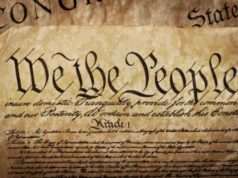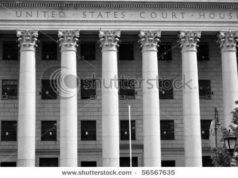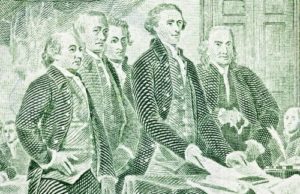Table of Contents

Texas v. Johnson: A Landmark Case in Defending Freedom of Expression
Introduction
Texas v. Johnson, a landmark case in American legal history, stands as a testament to the enduring struggle for freedom of expression. This pivotal Supreme Court case, decided in 1989, revolved around the act of flag desecration and its implications on the First Amendment. At its core, Texas v. Johnson grappled with the fundamental question: to what extent can the government restrict an individual’s right to free speech, even when that speech is controversial or offensive? This article delves deep into the case’s background, legal arguments, and its lasting impact on the interpretation of the First Amendment.
The Incident
The origins of Texas v. Johnson can be traced back to a fateful day in 1984 when Gregory Lee Johnson, a protestor, participated in a demonstration against the Republican National Convention in Dallas, Texas. The demonstration was organized to voice opposition to various policies, including nuclear weapons and capitalism. However, what gained national attention was Johnson’s act of burning the American flag as part of the protest. In the process, he chanted slogans like “America, the red, white, and blue, we spit on you” and “the flag of the tyrants,” effectively turning the act into a symbolic expression of dissent.
Arrest and Conviction
Johnson’s act did not go unnoticed, and he was arrested and charged with violating a Texas law that prohibited the desecration of the American flag. Under the Texas law, flag desecration was considered a criminal offense, and Johnson was found guilty by a Texas court, leading to his conviction and a one-year jail sentence, along with a $2,000 fine.
Legal Journey
Johnson’s case, however, did not end with his conviction. It set off a legal journey that would ultimately redefine the boundaries of free speech in America. Johnson, represented by attorney William Kunstler, appealed his conviction to the Texas Court of Criminal Appeals, where he argued that his act of flag burning was a form of symbolic speech protected by the First Amendment.
The First Amendment
Before delving into the legal arguments presented in Texas v. Johnson, it is essential to understand the First Amendment to the United States Constitution, which serves as the bedrock of free speech protection. The First Amendment reads, “Congress shall make no law respecting an establishment of religion, or prohibiting the free exercise thereof; or abridging the freedom of speech, or of the press; or the right of the people peaceably to assemble, and to petition the Government for a redress of grievances.”
This amendment enshrines the right to freedom of speech as one of the fundamental rights granted to American citizens. It prohibits the government from making laws that abridge or restrict an individual’s right to express themselves, ensuring that citizens have the liberty to voice their opinions, even when those opinions are unpopular or controversial.
The Legal Arguments
The legal arguments presented in Texas v. Johnson centered on whether Johnson’s act of flag burning qualified as a protected form of expression under the First Amendment or whether it could be regulated as an act of “fighting words” or “incitement” outside the realm of protected speech.
1. Symbolic Speech: Johnson’s primary argument rested on the notion that his act of flag burning was a form of symbolic speech. Symbolic speech involves conveying a message or expression through non-verbal means, such as gestures or actions. Johnson contended that burning the American flag was his way of expressing dissent and dissatisfaction with certain government policies, and therefore, it fell under the purview of protected speech.
2. Government Interests: The state of Texas, on the other hand, argued that its interest in preserving the flag as a symbol of national unity and pride justified the restriction on flag desecration. Texas contended that flag desecration, in this case, was not a protected form of expression but rather an act that could incite violence or provoke a breach of the peace.
3. Precedent: Another aspect of the legal arguments involved previous Supreme Court decisions on free speech, most notably the 1969 case of Brandenburg v. Ohio. In Brandenburg, the Supreme Court held that speech could only be restricted if it incited imminent lawless action. Johnson argued that his act of flag burning did not meet this standard and should be protected under the First Amendment.
The Supreme Court’s Decision
In a 5-4 decision delivered on June 21, 1989, the Supreme Court ruled in favor of Gregory Lee Johnson, holding that flag burning, even when offensive and provocative, was a form of protected speech under the First Amendment. Justice William Brennan, writing for the majority, argued that the government could not prohibit expression simply because it was offensive or disagreeable. He stated, “If there is a bedrock principle underlying the First Amendment, it is that the government may not prohibit the expression of an idea simply because society finds the idea itself offensive or disagreeable.”
The majority opinion emphasized that flag burning, in this case, was a form of symbolic speech and that the government’s interest in preserving the flag as a symbol of national unity did not justify suppressing Johnson’s expression. Justice Brennan’s opinion noted that the government’s authority to restrict speech was limited to cases where speech incited imminent lawless action, a standard set forth in the Brandenburg case.
Dissenting Opinions
The dissenting justices in Texas v. Johnson expressed concerns about the decision’s implications for the sanctity of the American flag and the potential for future challenges to laws prohibiting flag desecration. Justice Antonin Scalia, in his dissent, argued that the flag held a unique and honored place in American culture, and flag desecration was a direct attack on the symbol of the nation.
Impact and Legacy
Texas v. Johnson had a profound and lasting impact on the interpretation of the First Amendment and freedom of expression in the United States. Here are some key aspects of its legacy:
1. Symbolic Speech Protection: The case reinforced the protection of symbolic speech as a form of expression under the First Amendment. It established that actions and symbols can convey powerful messages and should be safeguarded as long as they do not incite imminent lawless action.
2. Controversial Speech Protection: The decision affirmed that even speech considered offensive or deeply divisive is protected by the First Amendment. It underscored the principle that government censorship should be limited and that individuals have the right to express dissenting views.
3. Limits on Government Power: Texas v. Johnson set a significant limit on the government’s power to regulate speech. The government cannot suppress speech merely because it disagrees with the message or finds it offensive. It can only restrict speech when there is a compelling interest and an imminent threat of lawlessness.
4. Ongoing Debate: The case continues to fuel debates about the limits of free speech and the role of symbols in public discourse. It remains a touchstone for discussions on the balance between protecting individual expression and preserving national symbols.
Conclusion
Texas v. Johnson stands as a seminal case in the annals of American jurisprudence, exemplifying the enduring commitment to freedom of expression. The Supreme Court’s decision reaffirmed the principle that the First Amendment protects even the most controversial and provocative forms of speech. It reminds us that the true test of a society’s commitment to free speech lies in its willingness to protect speech that challenges the status quo and provokes uncomfortable conversations. Ultimately, Texas v. Johnson is a testament to the enduring importance of the First Amendment in safeguarding the liberties that define America.
Introduction
The Texas v Johnson case is a landmark decision by the United States Supreme Court that addressed the question of whether flag burning is a protected form of free speech under the First Amendment of the US Constitution. The case involved the arrest of Gregory Lee Johnson for burning an American flag during a political demonstration outside the Republican National Convention in Dallas, Texas. The Supreme Court’s decision in Texas v Johnson established that flag burning is a protected form of symbolic speech under the First Amendment.
Background
On August 22, 1984, Gregory Lee Johnson participated in a political demonstration in Dallas, Texas, where he burned an American flag in protest of the policies of the Reagan administration. Johnson was arrested and charged with violating a Texas state law that prohibited the desecration of a venerated object.
Johnson’s case eventually made its way to the United States Supreme Court, which agreed to hear the case to determine whether flag burning was protected as a form of symbolic speech under the First Amendment.
The Court’s Decision
In a 5-4 decision, the Supreme Court held that flag burning was a form of symbolic speech protected under the First Amendment. The Court rejected the state of Texas’s argument that the flag was a unique and venerated symbol that deserved special protection, and held that Johnson’s burning of the flag was a form of political speech protected by the First Amendment.
The Court emphasized the importance of protecting unpopular speech, stating that “if there is a bedrock principle underlying the First Amendment, it is that the government may not prohibit the expression of an idea simply because society finds the idea itself offensive or disagreeable.”
Impact and Legacy
The Texas v Johnson decision had a significant impact on the interpretation and application of the First Amendment’s protection of free speech. The decision established that freedom of speech protects not only the content of speech, but also the symbolic expression of that speech, even if it is offensive or unpopular.
The decision has been cited in subsequent cases related to the protection of free speech, and has influenced the ongoing debate surrounding the balance between free speech and public order. The decision has also sparked controversy, with some arguing that flag burning is a form of disrespect and should not be protected under the First Amendment.
The Texas v Johnson decision remains an important part of American legal history and continues to shape the interpretation and application of the First Amendment’s protection of free speech.
Conclusion
The Texas v Johnson case is a landmark decision by the US Supreme Court that established that flag burning is a protected form of symbolic speech under the First Amendment. The decision emphasized the importance of protecting unpopular speech and the right to express political ideas, even if they are offensive or disagreeable. The decision has had a significant impact on the interpretation and application of the First Amendment’s protection of free speech, and has influenced the ongoing debate surrounding the balance between free speech and public order. The Texas v Johnson decision remains an important part of American legal history and continues to shape the interpretation and application of the First Amendment’s protection of free speech.
Texas v. Johnson: The Background
The case of Texas v. Johnson revolves around the 1984 Republican National Convention which took place in Dallas, Texas. At this event, Gregory Lee Johnson engaged in a protest by setting fire to the American flag.
Gregory Lee Johnson was a member of a private company that was made up of individuals who promoted the Communist movement. Johnson lit fire to the flag at the convention to protest capitalism and the way the government was being run.
When he started burning the flag, he was immediately taken into custody and arrested by the Dallas Police Department on the grounds that he had violated a state law that said it was illegal to destroy items or objects that are considered to be respected. For burning the American flag, Gregory Lee Johnson was fined a total of $2,000.
In response to the fine, Gregory Lee Johnson appealed the decision and took his case to the United States Supreme Court.
Texas v. Johnson: The Case Profile
Texas v. Johnson was heard on March 21st of 1989. Gregory Lee Johnson appealed the arrest and fine sparked by his flag-burning activities by stating that the Dallas police department had violated his 1st Amendment rights. As an American citizen, the 1st Amendment preserves and protects the right of speech and expression.
In addition to the protections offered in the 1st Amendment, Gregory Lee Johnson believed that the state law was not appropriate because the government cannot define what a “respected” object is. Texas v. Johnson was decided on June 21st of 1989 by the United States Supreme Court.
Texas v. Johnson: The Verdict
The United States Supreme Court ruled that Gregory Lee Johnson’s civil liberties and constitutional liberties were indeed violated as a result of his arrest and fine. The United States Supreme Court in Texas v. Johnson claimed that the man’s expression of burning the flag is protected and legal according to the United States Constitution.
Johnson won the case because of the rights and liberties granted by the 1st Amendment to the United States Constitution. This amendment awards American citizens the freedom to express themselves and say whatever they want so long as their speech does not place an immediate threat to the well-being of the nation.






















